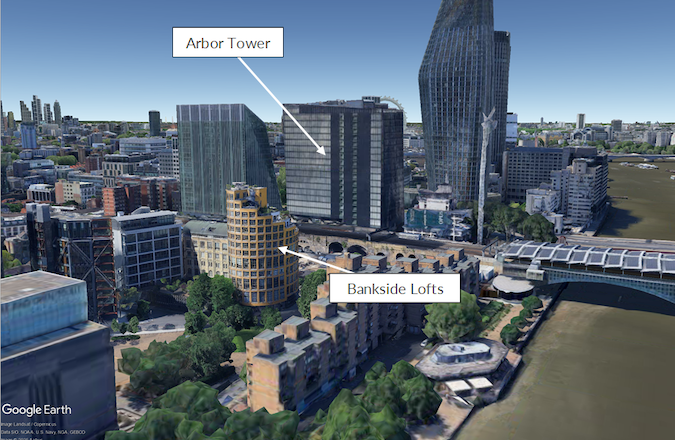A recent High Court ruling has seen a couple awarded £500,000 in damages after the construction of a 17-storey office tower significantly reduced natural light to their home [1]. A neighbouring resident also received a further £350,000, bringing the total compensation to £850,000. The claimants stated that the blocking of light made it difficult for them to read in bed [2].
The court found that the Arbor Tower, part of the Bankside Yards development, had infringed the legal right to light of the residents, of the Bankside Lofts. Right to Light is a property right which, if impacted significantly, can trigger either an injunction to prevent (or reverse) the infringement or a financial compensation [3]. In this case, the court declined to order the removal or modification of the building, citing broader public interest [4,5] and the ineffectiveness of demolition due to planning permission allowing a re-build [6]. Nonetheless, the compensation awarded was substantial.
Why This Matters – Legal Risk Beyond Planning
This case highlights that legal Rights to Light can have lasting implications even once planning permission has been obtained. Developers may assume that light concerns are entirely resolved through daylight and sunlight assessments submitted as part of the planning process. Right to Light, however, is a legal matter and entirely separate from planning.
The court reaffirmed that the reduction in light was substantial and affected the claimants’ ordinary enjoyment of their homes. “I conclude that the light remaining in the principal bedroom and the LKD of flat 605, and in the principal bedroom of flat 705, in scenario CS1 will be insufficient for the ordinary use and enjoyment of those rooms.” [7]
It’s worth noting that traditional assessment methods, such as the Waldram method, continue to hold sway in legal context. While radiance modelling can provide more detail, courts remain inclined to rely on established methods when determining whether light infringements are significant [8].
As stated within the court documents in response to ‘Is the Waldram method reliable?’ It is noted that “…it is common ground that the Waldram method is the industry standard and is used by everyone. It was used by Mr Ingram’s firm to assess the likely impact of Arbor and other buildings to be built on Bankside Yards on local residents and business occupiers, and to identify those properties where there was likely to be rights of light issues. It was then used as the basis of settlement offers made by GIA. It has been used in that way for about 100 years without much demur to the reliability of its results. The Page 51 High Court Approved Judgment Cooper v Ludgate House Ltd RICS Professional Standard, Rights of Light (3rd ed. 2024), endorses it, while stating that experts should be aware of other methods of measurement and may wish to use them, as an alternative. Mr Ingram accepted that it would only be in a case where there was a real dispute that might go to court that his firm would consider using other methods, such as Radiance.” [9]
The defendants position on this was stated within the court documents, “…(the defendant) ultimately rejects the Waldram method as being inaccurate and outmoded, in favour of an analysis based on other methods, primarily the median daylight illuminance method (“MDI”) but also the median daylight factor (“MDF”). Both of these are contained in a British Standard giving effect to a 2018 European Standard (BS EN 17037:2018), called “Daylight in Buildings” (“the 2018 BS”), which provides standards for the design of new buildings. These assessments are carried out using a computer software package called “Radiance”. The methods do not purport to be a standard for assessing whether interference with rights of light is actionable, but there is obviously considerable overlap between the process of designing buildings to maximise the ingress of daylight and sunlight and the assessment of whether sufficient light exists within a property for ordinary purposes.” [10]
The claimant criticised the modelling methods used by the defendant, “he departs from the BRE Guidance and 2018 BS in ways that alter the impression given by the Radiance results: by dividing the LKD into two and by using the living room MDI target rather than the kitchen target…” and “he cherry picks the results of the BRE tests: when a result supports a conclusion of sufficiency or non-substantiality, he relies on it; when it does not support that conclusion, he rejects it in favour of the Radiance assessments” [11]
How Pager Power Helps Developers Stay Ahead on Right to Light
At Pager Power, we help clients identify and address potential Right to Light risks early on. We encourage developers to address concerns before construction begins. Our assessments provide a clear picture as to the extent of the potential impact. We also outline practical options to reduce the impact to acceptable levels.
It is important to note that courts may take a more lenient view where developers can show they’ve acted transparently, explored mitigation options, and communicated with affected neighbours, “the developer’s proactive contact with the neighbours was one of the factors contributing towards the refusal of the injunction.” [12] – Sophie Schultz, Partner, Stephenson Harwood
Conclusion – Don’t Let Light Become a Legal Liability for your Development
It’s vital to distinguish between planning policy and legal rights. Daylight and sunlight assessments are typically submitted to local authorities to demonstrate compliance with BRE guidance in order to obtain planning permission. The Cooper v Ludgate House case is a clear reminder that light issues don’t end when planning permission is granted.
Courts are willing to award significant financial compensation for infringements on the legal Right to Light, even where no injunction is granted. The potential cost of overlooking these legal constraints can be substantial.
If you’re planning a development near to existing buildings, it’s worth speaking to an expert on light, like Pager Power, as early on as possible. A Right of Light Assessment can help you move forward with your project with confidence and avoid costly surprises later down the line.
If you require assistance on any of your projects, please get in touch on our website or call us on +44 (0)1787 319001.
References
[1] https://metro.co.uk/2025/07/10/couple-awarded-500-000-17-storey-office-tower-made-hard-read-bed-23625809
[2] https://www.standard.co.uk/news/london/south-bank-couple-wins-500k-luxury-skyscraper-blocked-light-b1237452.html
[3] https://www.gov.uk/government/publications/rights-to-light
[4] https://www.pinsentmasons.com/out-law/news/office-owner-wins-rights-light-case
[5] https://www.addleshawgoddard.com/en/insights/insights-briefings/2025/real-estate/rights-of-light-what-developers-need-know-about-bankside-yards-case/
[6] https://www.mishcon.com/news/high-court-finds-rights-of-light-infringement-but-refuses-injunction-in-bankside-yards-regeneration-scheme
[7] https://s47657.pcdn.co/wp-content/uploads/2025/07/Cooper-v-Ludgate-House.pdf
[8] https://www.mishcon.com/news/high-court-finds-rights-of-light-infringement-but-refuses-injunction-in-bankside-yards-regeneration-scheme
[9] https://s47657.pcdn.co/wp-content/uploads/2025/07/Cooper-v-Ludgate-House.pdf
[10] https://s47657.pcdn.co/wp-content/uploads/2025/07/Cooper-v-Ludgate-House.pdf
[11] https://s47657.pcdn.co/wp-content/uploads/2025/07/Cooper-v-Ludgate-House.pdf
[12] https://www.stephensonharwood.com/insights/rights-of-light-update-cooper-v-ludgate-house-powell-v-ludgate-house-2025-ewhc-1724




